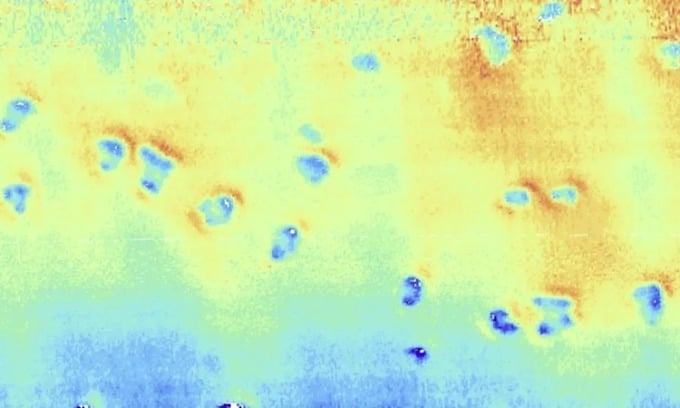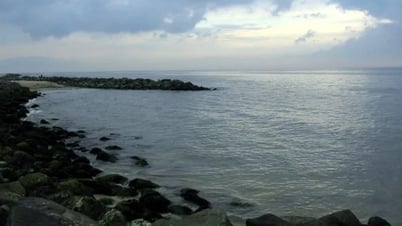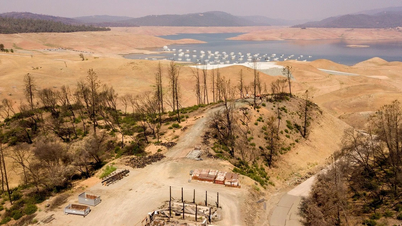Holes ranging from a few meters to 60 meters wide scattered across the seabed off the coast of Germany were initially thought to be caused by methane gas, but were actually created by porpoises.

Shallow holes in the North Sea were initially thought to be caused by methane leaks. Photo: Jens Schneider von Deimling
Beneath the murky waters of the North Sea, shallow holes dot the seafloor. These holes are circular or oval, ranging from a few meters to more than 60 meters wide, but only 11 meters deep. Some even merge together, creating depressions that resemble a cluster diagram. Such shallow holes are often formed when liquid containing methane or other groundwater bubbles up from sediment. But research published in the journal Communications Earth & Environment suggests that thousands, or even millions, of holes in the North Sea may be the work of porpoises foraging for food. The findings suggest porpoises and other animals may play a big role in shaping the seafloor, Live Science reported on February 27.
For years, geologist Jens Schneider von Deimling of Kiel University wondered if the shallow hole in the North Sea was caused by a methane leak. The North Sea floor is made of loose sand and has strong ocean currents, which are not suitable for methane to accumulate in sediments. Mapping studies using echosounders have not detected methane.
To better understand the mysterious shallow craters, the team used a multibeam echosounder, which allows them to survey the seafloor at high resolution. The new tool allowed the researchers to examine the shape of the craters down to the centimeter scale. The multibeam echosounder revealed that the shallow craters were not, in fact, conical in shape, as would be the case if methane gas were released through sediment, according to Schneider von Deimling. Regardless of their width, the craters were all about 11 centimeters deep.
In his search for the cause of the shallow pits, Schneider von Deimling consulted a biologist and diver friend who learned that porpoises ( Phocoena phocoena ) often scavenge the seafloor for sand eels. Following the call, Schneider von Deimling teamed up with biologists to study porpoises.
The team used existing models to predict porpoise and sand eel habitats, along with ocean current data. Both porpoises and sand eels live in areas with strong ocean currents. The researchers found that their habitats overlapped with the study area. Wherever porpoises and sand eels were predicted to be found, they found more holes. The large holes were created by porpoises and eroded by ocean currents.
The team is now working with scientists in Ireland to confirm their predictions of the hole’s location based on porpoise habitats in the North Sea. Interdisciplinary research like this can help biologists learn more about animal behavior. Understanding how shallow holes in the seafloor form is important for identifying underwater hazards. Holes caused by methane seeps could signal a threat from tectonic plates. If scientists can identify living organisms, they can quell concerns about tectonic activity.
An Khang (According to Live Science )
Source link


![[Photo] Keep your warehouse safe in all situations](https://vphoto.vietnam.vn/thumb/1200x675/vietnam/resource/IMAGE/2025/10/1/3eb4eceafe68497989865e7faa4e4d0e)
![[Photo] Hanoi morning of October 1: Prolonged flooding, people wade to work](https://vphoto.vietnam.vn/thumb/1200x675/vietnam/resource/IMAGE/2025/10/1/189be28938e3493fa26b2938efa2059e)
![[Photo] President of the Cuban National Assembly visits President Ho Chi Minh's Mausoleum](https://vphoto.vietnam.vn/thumb/1200x675/vietnam/resource/IMAGE/2025/10/1/39f1142310fc4dae9e3de4fcc9ac2ed0)




















![[INFOGRAPHIC] DJI Osmo Nano Action camera, super compact, 4K 120fps recording](https://vphoto.vietnam.vn/thumb/402x226/vietnam/resource/IMAGE/2025/10/1/8408489112ee446dab897373255c827e)










































































Comment (0)